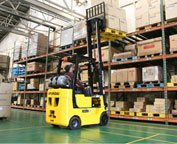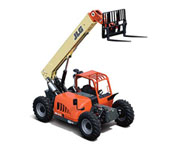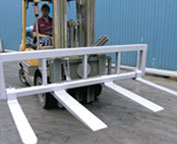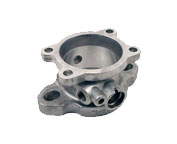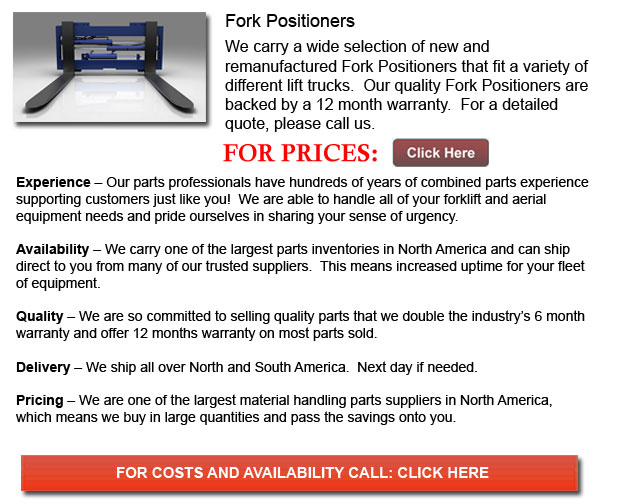Fork Positioner for Forklifts
Forklift Fork Positioner - The fork positioner is actually a hydraulic device that can allow the person driving to maneuver the lift truck without leaving the seat. They are made out of high quality materials and are meant to be able to endure the most challenging procedures and work environments. Side shifting units have the added ability to laterally position the entire load or the arms in order to facilitate more accurate lifting and position in a faster and more effective method.
The only one of its kind fork pocket design could enable the one operating it to safely sway the unit's forks without any fear of destroying the positioning cylinders. This can allow the operator the alternative to either execute simultaneous or independent blade movement, dependent upon the job requirement. For most lift trucks with non-OEM carriages, complete carriages are needed. Standard OEM carriages can be transformed into fork positioners on available units.
 Click to Download the pdf
Click to Download the pdf
Forklift Parts
Trek Part
Trek Parts - TREK Cleaning Machines is a machine maker who is passionate about the cleaning trade. The company's founders, Jim Hartsock, Chris Knowlton and Bob O'Hara, have over sixty years combined experience with effectively manufacturing, designing, developing, marketing and providing customer support. The company's cutting edge flair is a reflection of the entrepreneurial style of the founders. They strongly...
More
Cushion Tire Forklift Attachments
Cushion Tire Forklift Attachment - Cushion tires have a smooth profile on a firm tire with its tread being attached to a steel ring to be able to shape the tire. The tire is pressed on the hub that is then affixed onto the lift truck. These types of tires are suited for use in smooth floor warehouses and are...
More
JLG Forklift Part
JLG Forklift Parts - Following retirement in the late 1960's, John L. Grove started on a cross country RV expedition. After spending numerous years establishing his family built crane business with his brother, John had no idea that this journey would give birth to the rise of JLG Industries, Inc. The world leader of mobile aerial work platforms and precision...
More
Electric Scissor Lift Attachment
Electric Scissor Lift Attachments - There are numerous different styles of lift trucks on the market. Before making a purchase of one of these equipment, it is essential to be able to determine your needs. Know what model would best meet your work environment, budget and specific applications.
Electric powered lift trucks are appropriate for use in medium and big...
More
Fork Mounted Spreader Bar
Fork Mounted Spreader Bar - Commonly Used Lift Truck Attachments
Safety cages are vital as a safety feature for lift trucks. Normally they are utilized so as to hoist employees to particular height to allow them to make certain repairs. Furthermore, the safety cage could give them access to stored items at a height. Other items for instance, are needed...
More
Forklift Fork
Forklift Forks - At times equipment parts get old from use and they require changing. Companies could normally safe quite a bit of cash by just replacing individual parts as they get old rather than obtaining an entirely new equipment. Additional savings are available normally whenever replacing parts, there is the alternative to buy second-hand parts rather than new parts....
More
Sweeper and Scrubber Part
Sweeper and Scrubber Parts - The very first vacuum cleaners were invented in the 1860's. Luckily, floor cleaning machines and scrubbers have significantly changed ever since then. Daniel Hess made the first carpet sweeper in Iowa, USA. His model had a rotating brush along with an elaborate structure of bellows located on top to generate suction. We are fortunate nowadays...
More
Rough Terrain Forklift Attachment
Rough Terrain Forklift Attachments - There are actually two unique classifications of lift trucks within the material handling industry, the industrial model and the rough terrain model. Rough terrain lift trucks first arrived on the marketplace in the 1940's and were being primarily used on uneven roads, best for areas where no covered roads were accessible, like construction sites and...
More


![]() Click to Download the pdf
Click to Download the pdf

